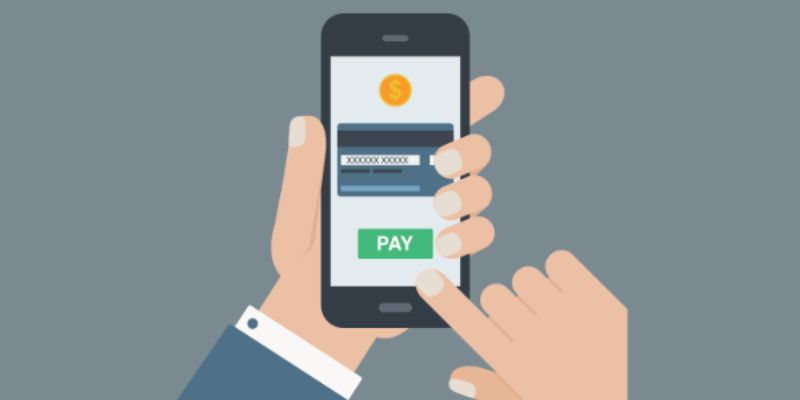Gone are the days of bulky wallets and waiting for change. Leading mobile payment platforms have changed the game, making buying and selling as simple as a tap on your screen. You can now pay for coffee, send money to a friend, or shop online without ever touching cash or cards. It’s fast, it’s easy, and it’s here to shake up how we handle money. Dive in as we explore the transformation these platforms are driving in our daily transactions!
The Evolution of Mobile Payment Platforms
Understanding the Growth of Digital Wallets and Mobile Payments
Not so long ago, we paid with cash or cards. Today, smartphones rule. In stores, on trains, even at friends’ houses, we use mobile payment solutions. They’re quick, simple, safe. The apps on our phones, like digital wallets, let us zap money fast. Let’s dive deep here. Why are digital wallets trending up? They make buying a breeze and keep our money safe. Plus, we don’t have to lug around cards or cash.
Why more people use mobile pay? Many reasons! It’s handy. It’s everywhere now. Big stores, small cafes, even street markets have it. People just tap their phones to pay with NFC tech or scan a QR code and poof! They’ve paid!
Security? Top priority. Mobile payment security keeps getting better. Our data stays safe with cool tech like biometrics. That’s right, our faces or fingerprints guard our money now!
Analyzing the Increase in Mobile Payment Adoption Rates
Mobile payment adoption rates are climbing up, up, up! And there’s no sign they’ll stop. Let’s get what’s behind this surge. Well, for starters, folks love how easy it is. No more fumbling with bills or coins. Just a quick wave of your phone and you’re done! Even signing is rare now.
More people buy smartphones every day, and with them comes mobile pay. Even Gramps is on it! Countries far and wide, from the busy streets of New York to the bustling markets of Kenya, are tapping away. Peer-to-peer payment systems are also big now. Friends split pizza or cab fare with just a few taps.
What’s pushing this? App giants like Apple Pay, Android Pay, and Samsung Pay. They’re in a fierce fight for the top spot. Each offers something cool, like rewards or smooth design. They keep making mobile pay better and drawing in more users.
Retailers, big and small, see this. They get how mobile pay can boost their sales. They’re hopping on board, updating their old systems. Now they’re POS systems smile at mobile pay. This helps them sell more by making it a snap for us to pay.
All this growth shows in the stats. Studies reveal more people now reach for phones over wallets at checkout. That’s not all. The trend’s the same worldwide, not just here in the U.S. Even in places where banks are scarce, mobile pay is taking off. It helps people do business with ease. And it keeps their money safer.
In short, the rise in mobile pay is no fad. It’s how we’ll all transact, now and ahead. It’s shaping our tomorrow, making our money moves faster and safer. And believe me, it’s only going to get more exciting from here!

Safeguarding Transactions: Mobile Payment Security Protocols
Exploring NFC and Contactless Payment Technologies
Near Field Communication, or NFC, drives today’s contactless payments. Think of it as a handshake between your phone and the payment terminal, but it happens in a flash. You tap your phone and – beep – you’ve paid! This tech is not just fast; it’s also secure. Each time you tap to pay, it creates a unique code. This code is like a secret message between your device and the bank. It’s so good at keeping secrets that even if someone listens in, they can’t use that code again.
Now, not all phones have NFC. But that’s okay, because there are other ways to pay without touching cash. QR codes let you scan and pay. Imagine a barcode, but this one takes your payment info safely to the checkpoint. It turns your phone into a safe payment tool, quick and easy.
Best Practices for Preventing Mobile Payment Fraud
But with great tech comes great need for safety. Crooks are smart, but we can be smarter. Here’s how:
First off, lock down your phone. Use a hard-to-guess password and think of your phone like your wallet. You wouldn’t leave your wallet lying around, right? So keep your phone close.
Next, be picky about your apps. Use apps from places you trust, like your bank or big names like Apple Pay, Android Pay, and Samsung Pay. These apps have teams that work hard to keep your money safe.
Also, watch out for strange messages or calls. If someone asks you for your payment info over the phone, think twice. Real banks or apps will never call you for your password or PIN.
Stay up to date with updates. When your phone says it’s time for an update, go for it. These updates keep your payment apps tough against fraud.
If something looks off, say something. If your account shows a buy you didn’t make, call your bank right away. The faster you act, the better.
Stay informed, friends. Keep learning about how to keep your money safe. It’s a bad world for fraudsters, but a good one for us who stay smart.
Keep these tips in mind and use the superpowers of contactless payments with confidence. Stay sharp, stay safe, and keep tapping to pay!

User Experience and Accessibility in Mobile Payments
Comparing Mobile Wallets with Traditional Banking Methods
Mobile wallets beat old banks in how easy they are to use. They let you pay fast with a tap or a click. You don’t stand in line at a bank anymore. Your phone is your bank now. You check your cash, send money, and pay bills anytime, from anywhere. This change is huge.
Apps like Apple Pay, Google Wallet, and Samsung Pay have changed the game. They keep your card details safe and let you pay with a tap. And there’s more – peer-to-peer payments are a breeze now. No swap of cash or checks needed. Just pick a name or a number and send cash their way. It’s simple.
Enhancing Payment Experiences with Biometric Authentication
Now let’s make it even better. Add biometrics for safer, faster ways to pay. That’s where your body — like your finger or face — confirms it’s really you. No more forgotten passwords or stolen card scares. Just use your fingerprint or face, and off you go!
Mobile payment apps use these cool features for quick and safe checkouts. Stores love it too. NFC technology – that’s Near Field Communication – lets you pay without touching anything. You just wave your phone near the reader, and like magic, you’ve paid!
These mobile payment solutions lead to huge smiles at the checkout. We get to skip the hassle and keep our info locked tight. And the shops? They like it too. They see us walk in, tap, and take off with our stuff in no time. It’s all about fast and happy buying and selling.
So, when you think about where to stash your cash, consider your phone. You could be tapping and going, not waiting and worrying. With biometrics and these smart apps, your next buy could be a piece of cake – a safer, quicker cake, that is.
Future Trends: The Impact of Mobile Payments on Commerce
The Rise of Cryptocurrencies and Digital Payment Gateways in Retail
Stores are starting to say yes to Bitcoin and other digital cash. It’s a big shift. Retailers see how fast and simple it is for customers to use. Many folks now scan a QR code or tap their phone to pay with crypto. This is changing shopping a lot.
Let’s break it down. When you use crypto to buy stuff, it goes through a digital payment gateway. This is like a bridge from your digital wallet to the store’s bank. And guess what? It’s super quick! Money moves in seconds, not days.
But here’s the thing. When you use crypto, there’s no need for banks in the middle. This can save money and time for everyone. It also means anyone with a phone can shop or sell stuff, not just people with bank accounts.

Mobile Payment Solutions and Their Role in Shaping a Cashless Society
Imagine walking out the door without your wallet. Scary? Not anymore! Mobile payment solutions let us tap our phones and pay for anything, like magic.
Cash is taking a back seat while these new ways to pay take off. Countries around the world are seeing folks use less cash. They’re just tapping, scanning, and going on their way.
But why is this happening? Because it’s super easy. You tap your phone, and you’re done. No more counting bills or coins.
Have you heard of NFC payment tech? It’s what lets your phone talk to the cash register without touching it. This cool tool means you can pay in a flash, with no hassle.
What’s more, families and friends are splitting bills and sending money with just their phones. This is called peer-to-peer payment. No need for ATM trips or checks.
Now, think about a world without cash. It’s getting real, right? Mobile payment apps are helping everyone jump on this train. Even in far-off places, where banks are hard to find, phones are becoming wallets.
Here’s a big win – it’s safer too. Your phone can use your face or finger to make sure it’s really you spending the money. That’s biometric auth. It’s like having a super-smart security guard in your pocket!
But it’s not just for the tech-savvy. Money through mobile is for everyone. It’s breaking down walls so all people can take part in the new world of cashless.
Stores, big and small, are getting into mobile pay too. They’re putting in new systems that link up with phones. These POS systems make sure your buying trip ends with a smile.
So, mobile payment solutions are not just trendy. They’re turning the way we shop and share money upside down. And that’s not stopping anytime soon. Get ready for a future where your phone rules your money, your shopping, and, yes, your life!
In this post, we dove into how mobile payments have changed the way we buy. We looked at the boom in digital wallets, and how more people every day are switching from cash to tapping their phones. Keeping money safe while paying this way matters a lot. We talked about security steps like NFC and how to stop fraud. The feel of paying with mobile is slick, often easier than old bank methods. Things like using your fingerprint make it even more user-friendly. We can’t forget what’s coming next. Mobile payments are taking off in stores and online, helping us move towards a world with less cash. To wrap up, these changes are big and they are here to stay, making every swipe, tap, or click a part of our daily life. Remember, staying safe and up to date will let us make the most of this tech wave. Keep an eye on the future; it’s looking pretty cashless and very digital.
Q&A :
What Are the Top Mobile Payment Platforms Today?
With the explosion of mobile technology, numerous payment platforms have emerged to simplify transactions. Leaders in the industry include Apple Pay, Google Pay, and Samsung Pay, each offering seamless payment options backed by robust security measures. Additionally, emerging platforms like Venmo, PayPal, and Zelle are growing in popularity due to their ease of use and social features.
How Do Leading Mobile Payment Platforms Ensure Security?
Security is a top priority for mobile payment platforms. Most use a combination of tokenization, which replaces sensitive card data with unique identification symbols, and biometric authentication, such as fingerprint or facial recognition, to safeguard transactions. Additionally, end-to-end encryption is employed to protect data during transmission.
What Makes a Mobile Payment Platform Stand Out?
Key factors that differentiate mobile payment platforms include user experience, acceptance at merchants and banks, integration with other financial tools, and the availability of additional features like loyalty programs or financial management. Platforms that offer a balance between convenience, security, and wide acceptance often lead the market.
Can Mobile Payment Platforms Be Used Internationally?
Many leading mobile payment platforms have international capabilities, allowing for transactions in foreign currencies and across borders. However, the range of availability might differ based on partnerships with international banks and financial institutions. Users should check compatibility and potential fees before relying on mobile payments abroad.
What Future Trends Are Expected in Mobile Payment Technology?
The future of mobile payments is likely to be shaped by ever-evolving technology such as near-field communication (NFC), blockchain, and the rise of contactless transactions. Increased integration with other smart devices and the development of more personalized, AI-driven experiences are also expected. Embracing these innovations will keep platforms competitive in the rapidly advancing digital payment space.

